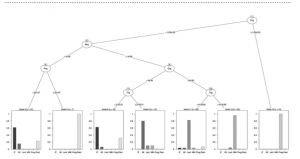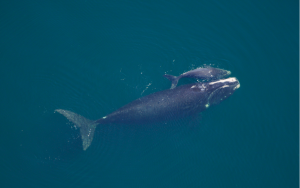A right whale pootree: classification trees of faecal hormones identify reproductive states in North Atlantic right whales (Eubalaena glacialis)
By Brenna Bales, SRC Intern
Faecal samples are a surprising wealth of information. One might think that the end product of digestion would not hold more information than simply what an animal has eaten, but in fact, animal excretions can give information about stress levels, sexual maturity, and physiological condition. In this analysis, 112 faecal samples of 81 individually identified North Atlantic right whales (NARW) (Eubalaena glacialis) were assayed for four hormone metabolites: cortisol (stress hormone), oestrogen (female sex hormone), testosterone (male sex hormone), and progesterone (female pregnancy hormone) (Corkeron et. al., 2017). The results were then used to classify each whale in a tree diagram, in one of the following categories: mature male (MM), immature male (IM), immature female (IF), pregnant female (Preg), lactating female (Lact), and resting female (mature, non-pregnant, non-lactating) (Rest) (Figure 1).

The constructed tree of known reproductive states of North Atlantic right whales (Eubalaena glacialis) (Corkeron et. al., 2017).
In order to confirm results, the hormonal identifications were compared with previously collected life-history data from the NARW Identification Database (Right Whale Consortium, 2012). The surveying efforts of these whales off the Eastern coast of North America extends back to 1986, with 80% of the population sighted each year (Hamilton et. al., 2007). This is key to confirming the results of a 13-year data set, and supplements the claims that NARWs are an ideal species for faecal analysis, due to the wealth of identification data. Furthermore, the consistent diet of the whales, minimal temperature variation in the study area, and the rapid collection of samples make this faecal hormone analysis possible.

A North Atlantic right whale and calf swim side by side. (source: http://www.noaanews.noaa.gov/stories2009/ images/whale_andcalf.jpg).
Cortisol hormone concentrations can also be used to identify stress levels in NARWs from anthropogenic impacts, similar to what has been done in killer whale (Orcinus orca) populations, relating boat traffic to stress (Ayres et. al., 2012). As environmental stressors continue to mount, wild, free-ranging marine animal populations are at risk. The confirmation of anthropogenic impact is essential, so appropriate conservation actions can be taken. In conclusion, this classification of sexual maturity is useful in estimating the proportion of breeding individuals in the NARW population, and hopefully can be used in future studies to assess the health and reproductive abilities of the population.
References
Ayres KL, Booth RK, Hempelmann JA, Koski KL, Emmons CK, Baird RW, Balcomb-Bartok K, Hanson MB, Ford MJ, Wasser SK (2012) Distinguishing the impacts of inadequate prey and vessel traffic on an endangered killer whale (Orcinus orca) population. PLoS One 7: e36842.
Hamilton PK, Knowlton AR, Marx MK (2007) Right whales tell their own stories: the photo-identification catalog. In SD Kraus, RM Rolland, eds, The Urban Whale: North Atlantic Right Whales at the Crossroads. Harvard University Press, Cambridge, MA, pp 75-104.
Right Whale Consortium (2012). North Atlantic Right Whale Consortium Identification and Sightings Databases 31 December 2012 (New England Aquarium, Boston, MA, USA).
